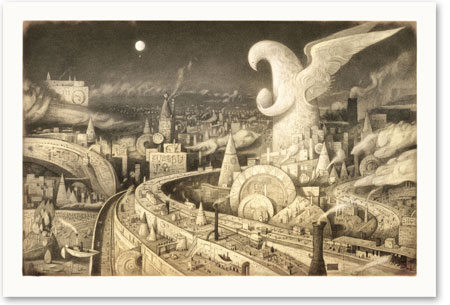Shaun Tan's "The Arrival"
These two graphic narratives don't seem to have a lot in common. But, in my mind, these are two narratives that could revolutionize not only the way people view the comics medium, but also the way people think. As a "newbie" to all of this, I was pleasantly overwhelmed by both of these works.
In "What it is" the reader is presented with a creative journey. Told with a mixture of identifiable panels and gutters, interactive pages, and rich, detail filled collages, Barry takes us through the journey of finding her voice and own personal style of creativity. The majority of the book is unrecognizable as a graphic narrative. At least, at first. Her collages make up the majority of the text. In one of the first collages she asks us "Q: What is an idea made of? A: Of future, past, and also meanwhile". This graphic narrative, this "idea" of hers, is made up of just that "future, past, and also meanwhile". When we do get the recognizable "panel and gutter" format Barry takes us from her as a grown woman, thinking about her past, to her as a curious, awkward child, to the lost youth and adolescent, and finally to the point of her revelation on creativity. When I stopped seeing the collages as just collages and began associating them with the intermediate panel and gutter sequences, how this graphic narrative was working as a graphic narrative clicked. In my opinion these richly detailed collages let us into the mind or mood of the "Lynda Barry" presen
 t in the previous, identifiable panels. In this way, the narrative is working on multiple levels. We get to read about Lynda Barry's life and experiences, experience, graphically, Lynda Barry's thoughts, and, through the activities and workbook provided, interact with Lynda Barry and, ultimately, our own creativity.
t in the previous, identifiable panels. In this way, the narrative is working on multiple levels. We get to read about Lynda Barry's life and experiences, experience, graphically, Lynda Barry's thoughts, and, through the activities and workbook provided, interact with Lynda Barry and, ultimately, our own creativity.Along with being a graphic narrative I think the term "graphic scrapbook" may be an appropriate term. The pages act as a reminder of a life lived and ask us to include our own interpretations and impressions. This is a narrative that not so much asks to be read through linearly, like most graphic narratives, but wandered through. You can spend hours, upon hours on one page deciphering the interplay and intricacy of the words and images, but just as easily you can take in the page as a whole and flow with it. Barry truly has created, as she says, "the formless thing which gives things form".
Shaun Tan's "The Arrival" likes to sneak up on people. The unsuspecting, worn looking cover hides a masterpiece of art and a new interpretation of the graphic narrative. "The Arrival" is a graphic narrative in the truest sense of the term. It is a strictly graphic re-telling of a man's story of immigration.
Strictly graphic, as in no words, at all.
A man's story of immigration, as in every man, woman, and child's story of immigration.
That is the beauty and strangeness of Tan's work. First he creates this surreal world where, as he puts it, there are "bird like birds", "tree like trees", "but photo realistic people". Other than surreal this book has also been termed a piece of "imaginative realism". There is also a look and feel of a distressed, old, photo album. This creates a very intimate experience for the reader; you feel like you are privy to someone's, perhaps even your own families, memories.

The journey of Tan's main character from his homeland to this new world quickly, as stated above, becomes the story of every immigrant. By using the above mentioned drawing techniques he creates a world very similar to ours, but almost tilted in someway. This "tilt" affect combined with the lack of words , and use of foreign symbols lets us experience the confusion, awe, and life of the immigrant arriving in a new world. We go along with the "man" as he tries to figure out where to live, work, what food's to eat, figure out strange social customs, and, most importantly, as he connects with other immigrants and hears their stories. Some of the most breathtaking panels are from these segments. We watch as a man and woman escape from certain death in their home country, a little girl's struggle to break free of slavery, a man's journey to war and journey home to find nothing but death and destruction. And, again, I can't stress how important it is that Tan did this all without words. We feel, understand, and follow the stories contained in "The Arrival" strictly by viewing and interpreting the images. Although not a typical graphic narrative, Tan has effectively opened the door for a new way of interpreting the medium, and what a magnificent interpretation it is.
Until next time,
GN

No comments:
Post a Comment